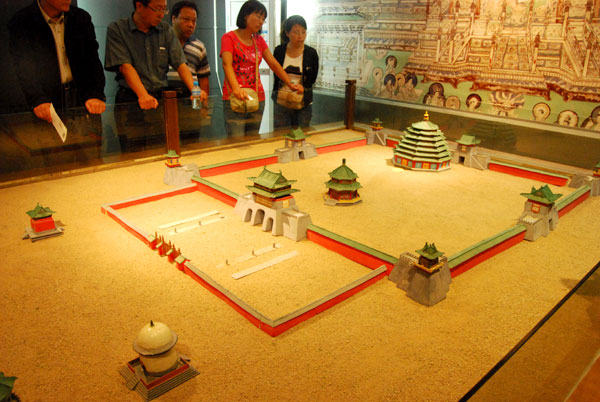A lost people
 |
|
A downsized replica of the original mausoleums, believed once to be as splendid as Beijing's iconic Ming Tombs. Hu Tong / For China Daily |
But many smaller mounds belonging to imperial relatives or left empty - presumably as red herrings to sidetrack tomb raiders - occupy surrounding farmlands.
However, most tombs are rarely visited, as they are dispersed, difficult to reach and in ruin. Many believe they might be constellated as such to emulate prominent heavenly bodies' positioning.
While the rulers' tombs are crumbling, the four corner towers, sacrificial halls and mourning platforms surrounding each of them have eroded almost beyond recognition.
Yet, even in its original splendor, the 50-sq-km burial complex would offer deficient testimony of the dynasty that ruled about 830,000 sq km of today's Ningxia, Gansu province, much of the Inner Mongolia and Xinjiang Uygur autonomous regions, some of outer Mongolia, and northern Shaanxi and eastern Qinghai provinces.
The Western Xia dominated this sphere by counterbalancing expansionist hostility against land-lusting neighbors - the Song (960-1279), Jin (1115-1234) and Liao (916-1125) dynasties.
The dynasty was founded when Li Yuanhao's father, Li Deming, crushed the Huang Chao peasant insurgence on behalf of the declining Tang Dynasty (AD 618-907).
Li Yuanhao prolonged power by resisting Song subjugation after the Tang expired. But the last emperor was unable to fend off Genghis Khan's unified Mongolia, which launched six campaigns against the Western Xia in the two decades preceding the empire's fall.
The conquest took the lives of not only the Western Xia's last ruler but also tens of thousands of civilians. Many tribes were totally exterminated.
Some of the remaining Dang-xiang joined the Mongolian military. Others diffused around the continent. Artifacts bearing Dangxiang script from as late as the 16th century have been discovered in Central China.
The Western Xia Museum in the tomb complex houses more than 670 artifacts and more than 450 research papers on the empire.















